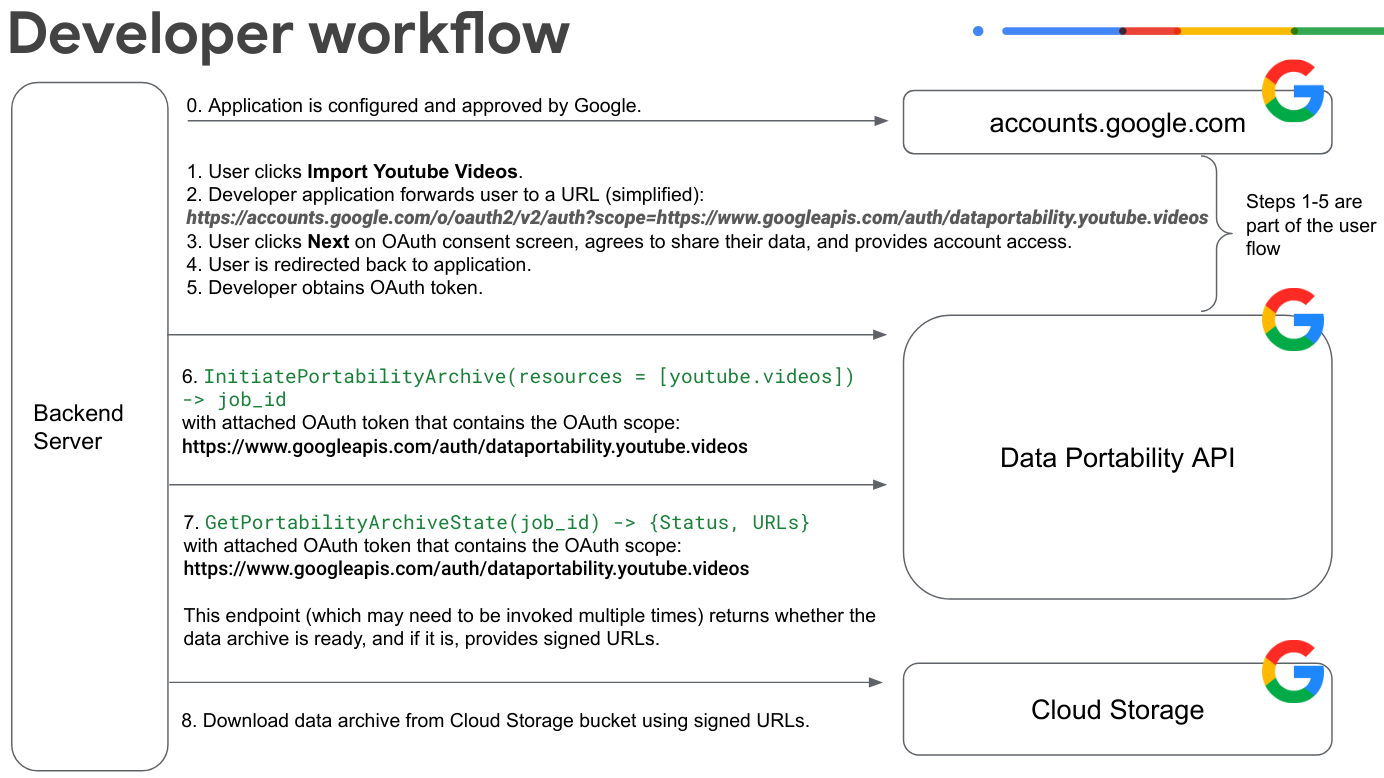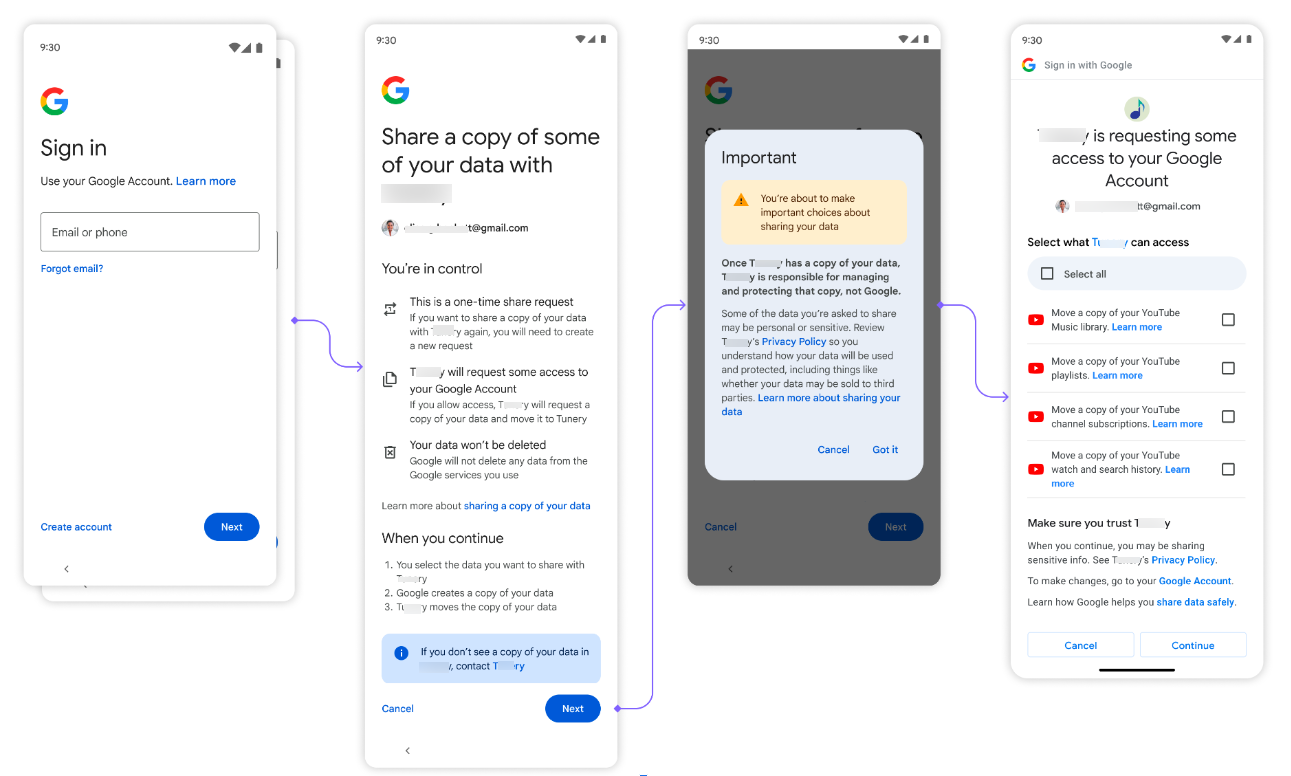API переносимости данных позволяет создавать приложения, которые запрашивают у пользователя разрешение на перемещение копии данных из сервисов Google в ваше приложение. Это обеспечивает переносимость данных и облегчает переключение услуг.
Если вы ищете информацию о том, как пользователи передают данные, см. раздел Как поделиться копией своих данных с третьим лицом .
Предварительные условия
Прежде чем выпускать ваше приложение, оно должно быть одобрено Google.
Вам также следует убедиться, что API переносимости данных доступен пользователям в вашем регионе. Список поддерживаемых стран и регионов см. в разделе «Общие вопросы» на странице «Отправка копии своих данных третьему лицу».
Рабочий процесс разработчика
Ниже приведены шаги, которые необходимо выполнить для создания приложения, использующего API переносимости данных.

Реализуйте поток согласия OAuth для пользователя. В этом примере пользователь предоставляет доступ к видеоданным YouTube.
Пользователь нажимает «Импортировать видео с YouTube» и входит в свою учетную запись Google.
Приложение перенаправляет пользователя на URL-адрес согласия OAuth. Обратите внимание, что этот пример URL-адреса упрощен и в нем отсутствуют некоторые параметры:
https://accounts.google.com/o/oauth2/v2/auth?scope=https://www.googleapis.com/auth/dataportability.myactivity.youtubeПользователь нажимает «Далее» на экране согласия OAuth, соглашается поделиться своими данными и предоставляет доступ к учетной записи.
Пользователь выбирает, какими данными делиться, а также время, в течение которого приложение может получать доступ к этим данным ( однократный доступ к своим данным или доступ по времени в течение 30 или 180 дней), а затем нажимает «Продолжить» .
Примечание . За 90 дней до истечения срока действия вашего токена OAuth пользователь имеет возможность продлить доступ к своим данным до истечения срока действия вашего токена OAuth. Кнопка продления не отображается, если у пользователя нет областей действия, срок действия которых истекает в течение 90 дней.
Примечание . Если пользователь хочет переключиться между однократным доступом и доступом на основе времени, ему придется снова пройти процедуру согласия после отзыва существующего разрешения. Вы можете отозвать грант с помощью
resetAuthorization(), или пользователь может отозвать его на странице своих подключений .Пользователь перенаправляется в приложение.
Разработчик получает токен OAuth для пользователя.
Ваше приложение вызывает
InitiatePortabilityArchive(resources = ["myactivity.youtube"])с прикрепленным токеном OAuth, который содержит эту область OAuth:https://www.googleapis.com/auth/dataportability.myactivity.youtubeЭтот вызов запускает процесс создания архива данных и отвечает идентификатором задания и указанием того, предоставил ли пользователь однократный или временной доступ.
Примечание . Одноразовый доступ означает один экспорт для каждой области . Если пользователь предоставляет несколько областей, вы можете создать отдельные задания для каждого ресурса, авторизованного токеном.
Ваше приложение вызывает
GetPortabilityArchiveState(job_id)с прикрепленным токеном OAuth, который содержит эту область OAuth:https://www.googleapis.com/auth/dataportability.myactivity.youtubeВы можете вызвать этот метод несколько раз, чтобы получить статус задания архивирования. Метод возвращает состояние задания. Если состояние
COMPLETE, архив готов и предоставлены подписанные URL-адреса облачного хранилища. Обратите внимание, что время, необходимое для выполнения запроса на архивирование, может варьироваться от минут до часов в зависимости от размера данных.Загрузите архив данных, используя подписанные URL-адреса.
Если пользователь предоставляет однократный доступ , вы вызываете
ResetAuthorization()с прикрепленным токеном OAuth, чтобы сбросить исчерпанные ресурсы и удалить все разрешения OAuth.Если пользователь предоставляет доступ на основе времени , вы можете экспортировать ресурсы каждые 24 часа, пока не истечет срок действия согласия.
Дополнительные сведения об использовании методов API переносимости данных см. в разделе Вызов методов API переносимости данных .
Как пользователи взаимодействуют с приложением API переносимости данных
На этой диаграмме показано, как пользователи взаимодействуют с приложением, интегрированным с API переносимости данных.

Во-первых, пользователю предоставляется возможность получить свои данные.
Затем пользователь входит в свою учетную запись Google.
Затем пользователь нажимает «Далее» , когда ему предлагается поделиться своими данными, и нажимает «Я понимаю» , когда ему предлагается принять политику конфиденциальности.
Затем пользователю отображается экран согласия OAuth, который позволяет приложению получить доступ к его данным. Указанные здесь параметры соответствуют настроенным вами областям OAuth. Пользователь выбирает, какими данными делиться и в течение какого времени приложение может получать доступ к этим данным ( однократный доступ к своим данным или доступ по времени в течение 30 или 180 дней), а затем нажимает «Продолжить» .
После разрешения доступа начнется импорт данных. В зависимости от размера данных выполнение запроса может занять от нескольких минут до нескольких часов.
